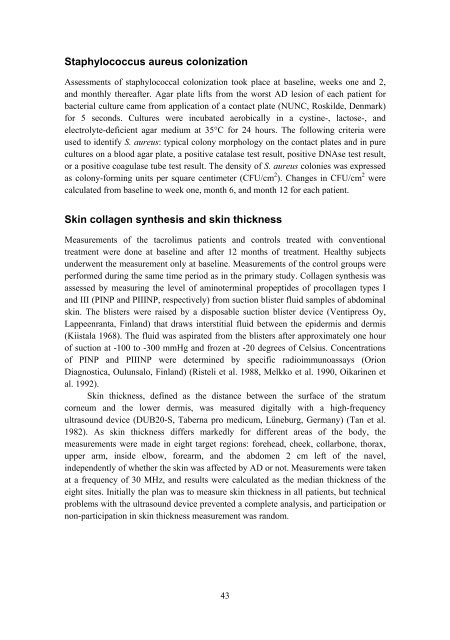Topical tacrolimus in atopic dermatitis: Effects of ... - Helda - Helsinki.fi
Topical tacrolimus in atopic dermatitis: Effects of ... - Helda - Helsinki.fi
Topical tacrolimus in atopic dermatitis: Effects of ... - Helda - Helsinki.fi
Create successful ePaper yourself
Turn your PDF publications into a flip-book with our unique Google optimized e-Paper software.
Staphylococcus aureus colonization<br />
Assessments <strong>of</strong> staphylococcal colonization took place at basel<strong>in</strong>e, weeks one and 2,<br />
and monthly thereafter. Agar plate lifts from the worst AD lesion <strong>of</strong> each patient for<br />
bacterial culture came from application <strong>of</strong> a contact plate (NUNC, Roskilde, Denmark)<br />
for 5 seconds. Cultures were <strong>in</strong>cubated aerobically <strong>in</strong> a cyst<strong>in</strong>e-, lactose-, and<br />
electrolyte-de<strong>fi</strong>cient agar medium at 35°C for 24 hours. The follow<strong>in</strong>g criteria were<br />
used to identify S. aureus: typical colony morphology on the contact plates and <strong>in</strong> pure<br />
cultures on a blood agar plate, a positive catalase test result, positive DNAse test result,<br />
or a positive coagulase tube test result. The density <strong>of</strong> S. aureus colonies was expressed<br />
as colony-form<strong>in</strong>g units per square centimeter (CFU/cm 2 ). Changes <strong>in</strong> CFU/cm 2 were<br />
calculated from basel<strong>in</strong>e to week one, month 6, and month 12 for each patient.<br />
Sk<strong>in</strong> collagen synthesis and sk<strong>in</strong> thickness<br />
Measurements <strong>of</strong> the <strong>tacrolimus</strong> patients and controls treated with conventional<br />
treatment were done at basel<strong>in</strong>e and after 12 months <strong>of</strong> treatment. Healthy subjects<br />
underwent the measurement only at basel<strong>in</strong>e. Measurements <strong>of</strong> the control groups were<br />
performed dur<strong>in</strong>g the same time period as <strong>in</strong> the primary study. Collagen synthesis was<br />
assessed by measur<strong>in</strong>g the level <strong>of</strong> am<strong>in</strong>oterm<strong>in</strong>al propeptides <strong>of</strong> procollagen types I<br />
and III (PINP and PIIINP, respectively) from suction blister fluid samples <strong>of</strong> abdom<strong>in</strong>al<br />
sk<strong>in</strong>. The blisters were raised by a disposable suction blister device (Ventipress Oy,<br />
Lappeenranta, F<strong>in</strong>land) that draws <strong>in</strong>terstitial fluid between the epidermis and dermis<br />
(Kiistala 1968). The fluid was aspirated from the blisters after approximately one hour<br />
<strong>of</strong> suction at -100 to -300 mmHg and frozen at -20 degrees <strong>of</strong> Celsius. Concentrations<br />
<strong>of</strong> PINP and PIIINP were determ<strong>in</strong>ed by speci<strong>fi</strong>c radioimmunoassays (Orion<br />
Diagnostica, Oulunsalo, F<strong>in</strong>land) (Risteli et al. 1988, Melkko et al. 1990, Oikar<strong>in</strong>en et<br />
al. 1992).<br />
Sk<strong>in</strong> thickness, def<strong>in</strong>ed as the distance between the surface <strong>of</strong> the stratum<br />
corneum and the lower dermis, was measured digitally with a high-frequency<br />
ultrasound device (DUB20-S, Taberna pro medicum, L�neburg, Germany) (Tan et al.<br />
1982). As sk<strong>in</strong> thickness differs markedly for different areas <strong>of</strong> the body, the<br />
measurements were made <strong>in</strong> eight target regions: forehead, cheek, collarbone, thorax,<br />
upper arm, <strong>in</strong>side elbow, forearm, and the abdomen 2 cm left <strong>of</strong> the navel,<br />
<strong>in</strong>dependently <strong>of</strong> whether the sk<strong>in</strong> was affected by AD or not. Measurements were taken<br />
at a frequency <strong>of</strong> 30 MHz, and results were calculated as the median thickness <strong>of</strong> the<br />
eight sites. Initially the plan was to measure sk<strong>in</strong> thickness <strong>in</strong> all patients, but technical<br />
problems with the ultrasound device prevented a complete analysis, and participation or<br />
non-participation <strong>in</strong> sk<strong>in</strong> thickness measurement was random.<br />
43

















